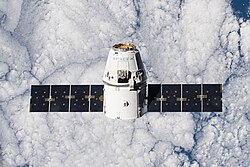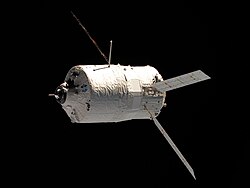Cygnus NG-18
| S.S Sally Ride | |||
 | |||
| Beställare | NASA | ||
|---|---|---|---|
| Uppkallad efter | Sally Ride | ||
| Tillverkare | Northrop Grumman Thales Alenia Space | ||
| Modell | Cygnus förstärkt | ||
| Operatör | Northrop Grumman | ||
| Färdens tid | 166 dag | ||
| NSSDC-ID | 2022-149A[1] | ||
| Uppskjutning | |||
| Startplats | MARS LP-0A, Wallops Flight Facility | ||
| Raket | Antares 230+ | ||
| Uppskjutning | 7 november 2022, 10:32:42 UTC | ||
| Återinträde | |||
| Återinträde | 22 april 2023, 03:12 UTC | ||
| Omloppsbana | |||
| Banlutning | 51,6° | ||
| Dockning | |||
| Rymdstation | ISS | ||
| Greppad | 9 november 2022, 10:20 UTC | ||
| Dockning | 9 november 2022, 13:05 UTC | ||
| Dockningsport | Unity, nadir | ||
| Ur dockning | 21 april 2023, 08:37 UTC | ||
| Släppt | 21 april 2023, 11:22 UTC | ||
| Tid dockad | 163 dag | ||
| Kronologi | |||
| |||
Cygnus NG-18 var en flygning av en av företaget Northrop Grummans Cygnus rymdfarkoster till Internationella rymdstationen (ISS). Farkosten sköts upp med en Antares 230+ raket, från Wallops Flight Facility i Virginia, den 7 november 2022.[2]
Farkosten kallas S.S. Sally Ride och är uppkallad efter den avlidna amerikanska astronauten Sally Ride.
Den 9 november 2022 dockades farkosten med rymdstationen med hjälp av Canadarm2.
Målet med flygningen var att leverera material och förnödenheter till ISS.
Den lämnade rymdstationen den 21 april 2023 och brann upp i jordens atmosfär den 22 april 2023.
Problem
Strax efter uppskjutningen, vecklades inte en av farkostens två solpaneler, ut. Man gjorde bedömningen att det inte skulle påverka dockningen med rymdstationen. Rymdsonden Lucy som använder samma typ av solpaneler, drabbades 2021 av ett liknande problem.[3]
Källor
Fotnoter
- ^ ”NASA Space Science Data Coordinated Archive” (på engelska). NASA. https://nssdc.gsfc.nasa.gov/nmc/spacecraft/display.action?id=2022-149A. Läst 5 december 2022.
- ^ Rob Garner (6 november 2022). ”Today’s Launch Postponed” (på engelska). NASA. https://blogs.nasa.gov/ng-crs-18/2022/11/06/todays-launch-postponed/. Läst 6 november 2022.
- ^ Jeff Foust (7 november 2022). ”Cygnus solar array fails to deploy” (på engelska). SpaceNews. https://spacenews.com/cygnus-solar-array-fails-to-deploy/. Läst 5 december 2022.
| ||||||||||||||||||||||
| ||||||||||||||||||||||||||||||||
Media som används på denna webbplats
The Expedition 37 crew captured Cygnus with the Canadarm2 at 7 a.m. EDT Sunday, Sept. 29, 2013, and attached it to the Harmony node at 8:44 a.m.
A Progress supply ship linked up to the orbiting International Space Station (ISS) at 3:48 GMT, November 18, bringing Expedition 1 commander William M. Shepherd, pilot Yuri P.
Gidzenko and flight engineer Sergei K. Krikalev two tons of food, clothing, hardware and holiday gifts from their families. The photograph was taken with a 35mm camera and the film was later handed over to the STS-97 crew members
for return to Earth and subsequent processing.Backdropped by a cloud-covered part of Earth, the Orbital Sciences' Cygnus cargo craft approaches the International Space Station, photographed by an Expedition 40 crew member. The two spacecraft converged at 6:36 a.m. (EDT) on July 16, 2014.
ISS021-E-017623 (30 Oct. 2009) --- Backdropped by a cloud-covered part of Earth, the unpiloted Japanese H-II Transfer Vehicle (HTV), filled with trash and unneeded items, departs from the International Space Station. European Space Agency astronaut Frank De Winne, Expedition 21 commander; NASA astronaut Nicole Stott and Canadian Space Agency astronaut Robert Thirsk, both flight engineers, used the station's Canadarm2 robotic arm to grab the HTV cargo craft and unberth it from the Harmony node's nadir port. The HTV was successfully unberthed at 10:18 a.m. (CDT) on Oct. 30, 2009, and released from the station's Canadarm2 at 12:32 p.m.
This image, photographed by one of the Expedition 42 crew members aboard the International Space Station, shows the SpaceX Dragon cargo craft approaching on Jan. 12 2015 for its grapple and berthing and the start of a month attached to the complex. Dragon carried more than 2 ½ tons of supplies and experiments to the station.
ISS026-E-037172 (24 Feb. 2011) --- Surrounded by the blackness of space, the European Space Agency's "Johannes Kepler" Automated Transfer Vehicle-2 (ATV-2) approaches the International Space Station. Docking of the two spacecraft occurred at 10:59 a.m. (EST) on Feb. 24, 2011.
NASA's patch for the Northrop Grumman Cygnus NG-18 commercial services resupply mission.










